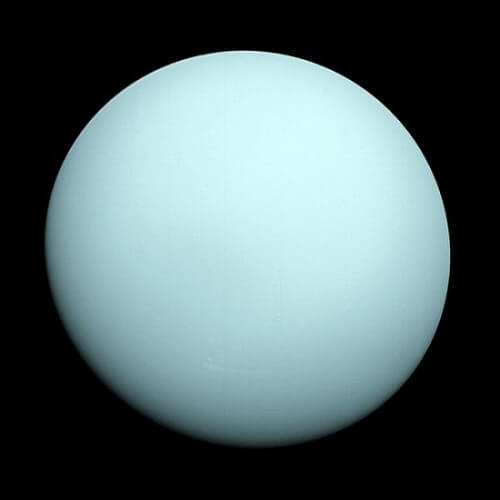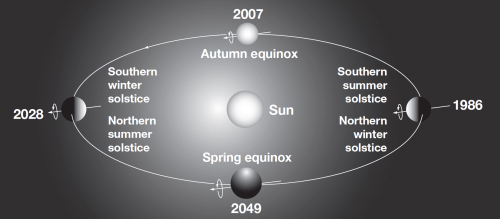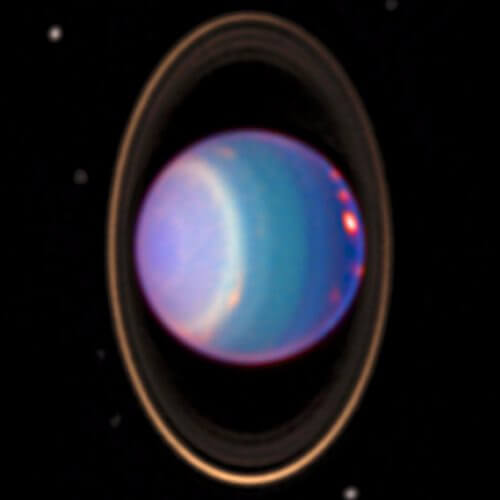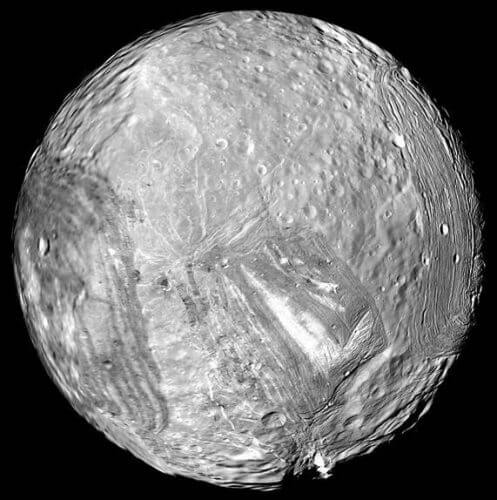The planet Uranus was studied closely only in a short and fast flyby by the Voyager 2 spacecraft, more than 30 years ago. What might a comprehensive research mission of the planet, its rings and moons look like?

Uranus is a planet that has not yet been thoroughly explored by a spacecraft that spends a long time in its midst. The only close-up pictures of it were taken by Voyager 2 which passed by in 1986, when it was on its way to Neptune. Uranus has its own rings, 5 moons the size of Saturn's small moons, and dozens more moons. Uranus is a lying planet - it actually rolls around itself during its movement around the sun, so its year is also its day. Sounds strange, but if readers find a graphic of its movement around the sun the picture will become clearer.
The strange movement of Uranus around itself is of great importance in planning the flight of a spacecraft that will one day go towards it. Spaceships launched to various destinations in the solar system move on the Malacca plane. If there is an intention to put the spacecraft into orbit around its equator, it will be necessary to operate the spacecraft's engines so that it "donates" above its trajectory, which requires a large amount of fuel. Considering that it will be required to explore its moons, it will also have to stay in their vicinity, which in any case also requires very large amounts of fuel.

There are two ways to explore the Uranus system. One way is to follow the path taken by the Galileo spacecraft, which explored Jupiter's moons, and the Cassini spacecraft, which is still exploring the Saturn system. In these cases, the spacecraft was put into orbit around the planets, and each time they would take advantage of the self-rotation of the planet and direct it towards a certain moon, the spacecraft would then return to the planet, make a partial circle around it, repeat the same principle of operation and fly towards another moon. In the case of Uranus, the spacecraft will enter orbit around Uranus and each time they will take advantage of its self-rotation and direct it towards another moon. The second way is to put the spacecraft into an equatorial orbit around its most distant moon. The spacecraft will stay near it for a certain period of time. At the end of its investigation, the spacecraft's engines will be activated in the direction of its movement around itself (similar to what was done by the Apollo spacecraft when it returned to Earth from the moon) and it will fly towards the next moon and so on. Since in every transition from one moon to another the spacecraft moves towards Uranus, it utilizes the gravitational force of Uranus itself, which enables fuel savings. The transition from moon to moon must be done when the moon that is close to it and the next moon are in resonance with each other in order to shorten the duration of the flight. Only after completing the investigation of the inner moon does the spacecraft enter orbit around Uranus.

Since the rings of Uranus are discrete, there is a large gap between one ring and the other, and it will be possible to take a course of action that cannot be done with the Cassini spacecraft. Towards the end of its mission the spacecraft will move towards a collision with Uranus as it moves within the rings similar to spacecraft moving within the asteroid belt launched towards the outer planets. In preparation for such a possibility, it would be useful to sample particles from the rings and examine them - from zero distance.
If the spacecraft survives the passage between the rings, it will head towards entering the atmosphere and explore it until it is destroyed. In this case, it would be good to equip her with microphones, and it would be good to record various noises. It will probably be possible to learn different things about the atmosphere from this, and maybe even record thunder.

As for the moons themselves, it is worth thinking even about small off-road vehicles that will move across them. The most intriguing moon is Miranda. It is a small moon with a diameter of 472 km, almost the size of Saturn's moon Enceladus, and it is also probably geologically active. They can therefore be considered planetary twins. For this moon, it would be worthwhile to plan its own SUV and SUV.
A task of this magnitude is enormous and will require international cooperation. I will present a bold idea and that is to initiate this project here in Israel. There is no shortage of talented people who would be more than willing to volunteer for this. The center of activity will be in Israel. Such a project is a long-term investment.

16 תגובות
The duration of its rotation around itself is indeed about 17 hours, my typing error.
The text does not match the diagram.
After checking on YouTube (Amir's link) and checking on Wikipedia it turns out that:
His day is 17 hours long.
The axis of rotation is almost parallel to the Milka plane. (of the country - about 67 degrees). As a result, at its poles there is half a year of day and half a year of night (the year of Uranus = 80 earthly years). In its equatorial region there is a "normal" day of 17 hours, but this is only during those parts of the year that its axis is perpendicular to the sun.
It is quite similar to Israel, at whose poles the day lasts 6 months and so does the night. In Uranus it is more extreme.
For all these questions go to Wikipedia and you will get a detailed explanation. It is better that you read the material in English since what is in Hebrew is an abbreviation of the English text. Giving a summary of a summary would miss the point. Regarding planets in a perpendicular plane, it seems to me that recently a small body was discovered that orbits the sun in this way.
What is the reason for the different rotation of Uranus?
What is the reason that stars line up around the sun in one plane and why do they usually rotate vertically to revolve around the sun?
Why, for example, are there no planets that revolve around the sun in a perpendicular plane? Galaxies also behave like this, why does the solar system and galaxies have a disk shape and not a sphere shape.
From a scientific pursuit, for example planetary geology and political science. and other areas. Some of them appear here in the science in my section, others in journals. Professionals.
If so, I take my hat off (not sarcastically)
Do you also write out of a scientific pursuit? Or did you form your opinion based on an external acquaintance with the world of science?
To clarify - I mean by the phrase "more than capable" that they will be enthusiastic. I hope the readers understand what I mean. In my profession, I edit my language and the ways of writing flow to me, what's more, I have hundreds of publications.
Graphics of its movement around the sun
https://www.youtube.com/watch?v=dV4EaMbLJsQ
"More mechanized" is the way people sometimes talk. There is no such expression. Like "I'll bring you ten shekels" is not an expression even though many people talk like that.
And regarding pictures, I didn't explain myself well. You talk about tilting the axis of rotation by 90 degrees and then write: "If the readers find a graphic of its movement around the sun, the picture will become clearer."
It's a bit amusing. I thought whoever wrote it would attach a graphic or a link to it. Of course this is not an expectation. You do a wonderful job volunteering
Definitely possible. There have already been such cases in the past. Example In 1976, two spacecraft were launched to Mars, these are the Viking spacecraft.
Shouldn't it be worth planning together and launching two spacecraft to the two outer planets Uranus and Neptune?
How different should the science equipment for the two planets be? And the drive system? And the energy source?
When they say "more than machines" there is a certain intention in this type of expression. A moment of Hebrew.
Exploring planets and moons without photographs is incomplete research. Without photographs it is impossible to get to know their surface and it is impossible to learn much about atmospheres. Try to think of research satellites orbiting the earth without cameras.
Kind of funny to send us looking for pictures.
By the way, there is no "more than mechanized". either ready or not.
The article itself is fascinating. Thanks
Not true. for two reasons
1. The computing and navigation equipment are constantly being improved, including artificial intelligence means, and in the event that there is a malfunction for any reason, the greater the chances are that the spacecraft will know how to repair itself
2. If there is a malfunction that requires it not to enter orbit around the farthest moon, the spacecraft's large amount of fuel and the moon's weak gravity will allow it to detach from it and enter orbit around Uranus.
The risk of the second way in the study of Uranus and its moons is that failure in the mission to unify the moons will prevent the study of Uranus itself which is the main part of the mission. The first way is better, where first he will study the planet itself and only later its moons,
Please respond gently dear stranger. Please be considerate late at night and maybe I'm wrong in my response. (:))